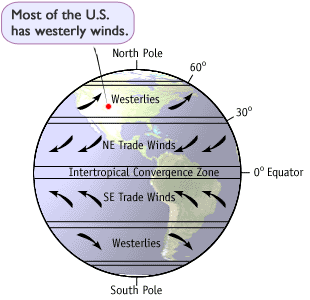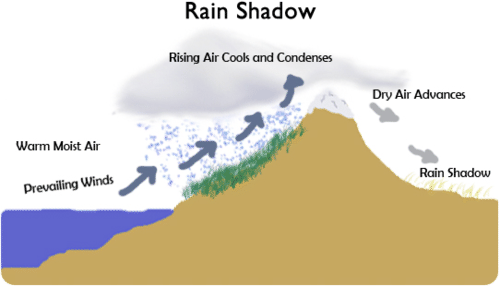17.1 Climate and Its Causes
17.1 Climate and Its Causes
Lesson Objectives
- Define climate.
- State how climate is related to latitude.
- Explain how oceans influence climate.
- Describe how mountains affect climate.
Vocabulary
- climate
- rain shadow
Introduction
One winter day in Chicago, the temperature hit 20° C (68° F). This would be normal for Miami in the winter, but in Chicago, it felt like a heat wave. The scene in Figure below is more typical for Chicago in the winter. The “heat wave” on that winter day is an example of weather. The typical temperature for that day is part of Chicago’s climate.

Cold and snow are typical for Chicago in the winter.
What Is Climate?
Climate is the average weather of a place over many years. It includes average temperatures. It also includes average precipitation. The timing of precipitation is part of climate as well. What determines the climate of a place? Latitude is the main factor. A nearby ocean or mountain range can also play a role.
Latitude and Climate
Latitude is the distance north or south of the equator. It’s measured in degrees, from 0° to 90°. Several climate factors vary with latitude.
Latitude and Temperature
Temperature changes with latitude. You can see how in Figure below
- At the equator, the Sun’s rays are most direct. Temperatures are highest.
- At higher latitudes, the Sun’s rays are less direct. The farther an area is from the equator, the lower is its temperature.
- At the poles, the Sun’s rays are least direct. Much of the area is covered with ice and snow, which reflect a lot of sunlight. Temperatures are lowest here.
Find the cool spot in Asia at 30° north latitude. Why is it cool for its latitude? (Hint: What else might influence temperature?)
Latitude and Precipitation
Global air currents affect precipitation. How they affect it varies with latitude. You can see why in Figure below.
Global air currents are shown on the left. You can see how they affect climate on the right.
Latitude and Prevailing Winds
Global air currents cause global winds. Figure below shows the direction that these winds blow. Global winds are the prevailing, or usual, winds at a given latitude. The winds move air masses, which causes weather.
The direction of prevailing winds determines which type of air mass usually moves over an area. For example, a west wind might bring warm moist air from over an ocean. An east wind might bring cold dry air from over a mountain range. Which wind prevails has a big effect on the climate. What if the prevailing winds are westerlies? What would the climate be like?
The usual direction of the wind where you live depends on your latitude. This determines where you are in the global wind belts.
Oceans and Climate
When a place is near an ocean, the water can have a big effect on the climate.
Coastal and Inland Climates
Even places at the same latitude may have different climates if one is on a coast and one is inland.
- On the coast, the climate is influenced by warm moist air from the ocean. A coastal climate is usually mild. Summers aren’t too hot, and winters aren’t too cold. Precipitation can be high due to the moisture in the air.
- Farther inland, the climate is influenced by cold or hot air from the land. This air may be dry because it comes from over land. An inland climate is usually more extreme. Winters may be very cold, and summers may be very hot. Precipitation can be low.
Ocean Currents and Climate
Ocean currents carry warm or cold water throughout the world’s oceans. They help to even out the temperatures in the oceans. This also affects the temperature of the atmosphere and the climate around the world. Currents that are near shore have a direct impact on climate. They may make the climate much colder or warmer. You can see examples of this in Figure below.
The Gulf Stream moves warm equatorial water up the western Pacific and into northern Europe, where it raises temperatures in the British Isles.
Mountains and Climate
Did you ever hike or drive up a mountain? Did you notice that it was cooler near the top? Climate is not just different on a mountain. Just having a mountain range nearby can affect the climate.
Altitude and Temperature
Air temperature falls at higher altitudes. You can see this in Figure below. Why does this happen? Since air is less dense at higher altitudes, its molecules are spread farther apart than they are at sea level. These molecules have fewer collisions, so they produce less heat.
Air temperature drops as you go higher.
Look at the mountain in Figure below. The peak of Mount Kilimanjaro, Tanzania (Africa, 3° south latitude) is 6 kilometers (4 miles) above sea level. At 3°S it’s very close to the equator. At the bottom of the mountain, the temperature is high year round. How can you tell that it’s much cooler at the top?
Mount Kilimanjaro has very different climates at the top and bottom.
Mountains and Precipitation
Mountains can also affect precipitation. Mountains and mountain ranges can cast a rain shadow. As winds rise up a mountain range the air cools and precipitation falls. On the other side of the range the air is dry and it sinks. So there is very little precipitation on the far (leeward) side of a mountain range. Figure below shows how this happens.
What role do prevailing winds play in a rain shadow?
Lesson Summary
- Climate is the average weather of a place over many years. It varies with latitude. It may also be influenced by nearby oceans or mountains.
- Temperature falls from the equator to the poles. Global air currents create wet and dry zones at different latitudes. They also create global winds.
- Oceans influence the climate of coasts. A coastal climate is mild. It may also get plenty of rain. An inland climate has greater temperature extremes. It can also be dry.
- The air is cooler as you go higher up a mountain. Mountain ranges can also cast rain shadows.
Lesson Review Questions
Recall
1. What is climate?
2. Describe how temperature changes with latitude.
3. Why are many deserts found near 30° latitude?
4. How does altitude influence temperature?
5. What is a rain shadow?
Apply Concepts
6. An ocean current flows from north to south off the western coast of a continent. The current flows close to land at 50° N latitude. Predict how the current affects the climate of the coast at that latitude. Explain your prediction.
Think Critically
7. Explain how prevailing winds influence climate.
8. Compare and contrast coastal and inland climates.
Points to Consider
In this lesson, you read how latitude, oceans, and mountains affect climate.
- Do you think you could predict the climate of a place, based on its location?
- Do you think that similar locations around the globe might have the same climate?
- Log in or register to post comments
- Email this page







